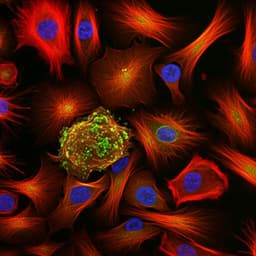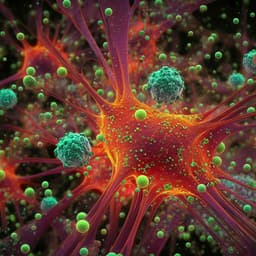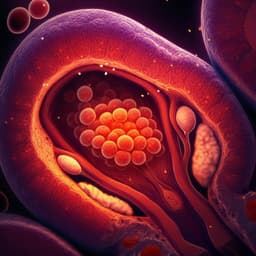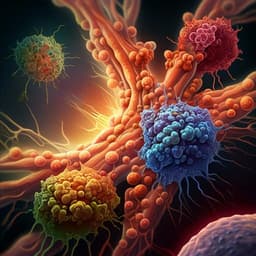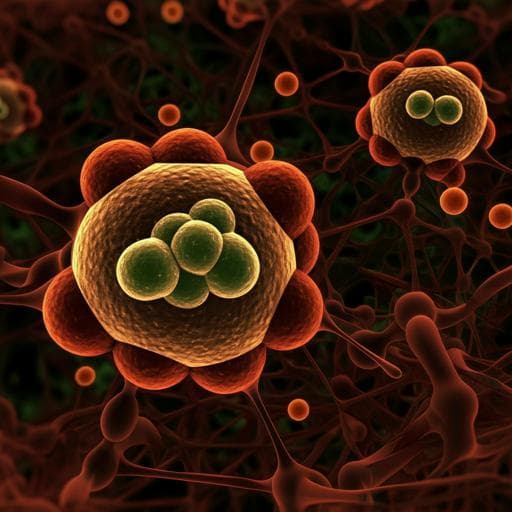
Veterinary Science
Single-nucleus and bulk RNA sequencing reveal cellular and transcriptional mechanisms underlying lipid dynamics in high marbled pork
L. Wang, X. Zhao, et al.
Discover the cellular and transcriptional mechanisms driving lipid deposition in marbled pork! This insightful study delves into the differences between Laiwu pigs with high and low intramuscular fat. Find out how specific adipocyte subpopulations contribute to marbling formation, conducted by a team of experts including Liyi Wang and Xueyan Zhao.
~3 min • Beginner • English
Introduction
The study addresses the cellular origins and transcriptional programs that govern intramuscular fat (IMF) deposition (marbling) in pork, a key determinant of meat quality traits such as flavor, tenderness, and juiciness. Although marbling is beneficial for pork quality, the underlying cell dynamics and regulatory mechanisms in skeletal muscle, particularly in highly marbled pork, are not well understood. Given that local Chinese pig breeds like the Laiwu pig exhibit high IMF but with substantial individual variation, the authors aim to elucidate the cell-type composition, adipocyte heterogeneity, and molecular pathways associated with high versus low IMF content using multi-omics. The purpose is to identify cellular contributors to IMF (e.g., adipocytes, fibro/adipogenic progenitors) and transcriptomic changes that correlate with lipid deposition, thereby informing strategies to increase IMF without compromising lean meat percentage or increasing subcutaneous fat.
Literature Review
The paper situates its work within advances in high-throughput transcriptomics (scRNA-seq, snRNA-seq, spatial transcriptomics) that have revealed diverse skeletal muscle cell types contributing to IMF, including satellite cells, fibro/adipogenic progenitors (FAPs), mesenchymal stem cells, endothelial cells, pericytes, side population cells, and myeloid-derived cells. snRNA-seq uniquely profiles multinucleated myofibers alongside mononuclear cells, but prior snRNA-seq studies have focused largely on mice, leaving a gap in livestock applications. Breed differences influence lipid deposition, with local Chinese breeds (e.g., Laiwu, Luchuan) showing higher TGs and DGs than lean breeds (e.g., Yorkshire, Duroc). Prior work also links sphingolipid metabolism to insulin resistance and highlights roles of glycerolipid and glycerophospholipid pathways in muscle lipid dynamics. These studies motivate applying snRNA-seq and lipidomics in pigs to dissect marbling formation mechanisms.
Methodology
Study design: Laiwu pigs were stratified by intramuscular fat (IMF) content into high (HLW) and low (LLW) IMF groups. Meat quality traits (n=6 per group) were measured. Multi-omics included lipidomics (n=5 per group), single-nucleus RNA-seq (snRNA-seq; 2 HLW and 2 LLW), and bulk RNA-seq (4 HLW and 4 LLW). Histology and immunofluorescence assessed tissue morphology and lipid-containing cells.
- Lipidomics: Longissimus dorsi muscle (LDM) samples underwent MTBE-based lipid extraction with internal standards. LC-MS/MS (Waters CSH C18 column; Thermo Q Exactive, positive/negative modes; DDA MS/MS). LipidSearch 4.0 for identification/quantification. Analyses examined total lipids, class composition, species-level differences, and acyl chain distributions.
- snRNA-seq: Nuclei isolated from LDM (Nuclei EZ Lysis buffer), filtered and counted. 10x Genomics Chromium Single Cell 3' v3 was used, targeting ~5,000 nuclei per library; libraries sequenced on Illumina NovaSeq 6000 (paired-end, ~20,000 reads/cell). Cell Ranger v6.1.2 aligned to Sus scrofa genome (Ensembl v96). QC retained 47,273 nuclei (genes per nucleus >500; mitochondrial gene percentage <25%); DoubletFinder removed doublets; Harmony corrected batch effects. Seurat v4.1.0 used for normalization (LogNormalize), PCA (top 10 PCs), SNN clustering, and t-SNE visualization; marker genes identified via Wilcoxon test.
- Subcluster analyses: Myofiber nuclei subtypes (Type I, IIa, IIx, IIb, NMJ, MTJ) and adipocyte subclusters identified by marker genes. FAPs/fibroblasts were subclustered (FAPs, fibroblasts, PDE4D+/PDE7B+). KEGG enrichment performed for clusters/subclusters.
- Trajectory and cell-cell communication: Monocle (v2.22.0; also mentions Monocle 3 usage) inferred pseudotime of FAP differentiation toward fibroblasts or PDE4D+/PDE7B+ states. CellPhoneDB v3.1.0 analyzed ligand–receptor interactions among 9 clusters.
- Lineage tracing and in vitro differentiation: FAPs isolated from pig LDM via magnetic sorting (PDGFRα/CD140a) and differentiated in 2D/3D adipogenic conditions (insulin, DEXA, IBMX). In vivo lineage tracing used Pdgfra-CreER; ROSA mT/mG mice with tibialis anterior (TA) glycerol injury; TA harvested at 14 dpi; adipogenesis assessed by perilipin staining and fluorescence. IMF cells from Pdgfra-CreER; ROSA mT/mG muscles were isolated and differentiated to quantify contribution of Pdgfra+ cells to adipocytes.
- Bulk RNA-seq: Total RNA (RIN>8) libraries (NEBNext Ultra) sequenced (Illumina HiSeq 150 bp). Reads filtered; aligned to Sscrofa11.1 (Ensembl Genes 103) with HISAT2; counts via featureCounts; expression via StringTie; DEGs via DESeq2 (P<0.05; |log2FC|>1 in key figure), with KEGG/GO enrichment (FDR P<0.05).
- Statistics: GraphPad Prism and R; unpaired two-tailed t-tests; data as mean±SEM.
Key Findings
- Meat quality and IMF: HLW pigs showed higher IMF content and pronounced marbling versus LLW, with reduced muscle fiber diameter, air dry moisture, and drip loss. pH (1 h and 24 h), L (lightness; 1 h and 24 h), and b (yellowness; 1 h and 24 h) values were higher in HLW; no significant difference in a (redness) or serum biochemical indices.
- Lipidomics: >3,301 lipid species detected (e.g., TGs=729, DGs=448, PCs=406, PEs=324). HLW had higher total lipid content and increased proportions of glycerolipids and sphingolipids. TG proportion: HLW 45.69% vs LLW 36.71%; PE proportion decreased in HLW (8.66% vs 13.57%). Class-level increases in HLW: TGs (P<0.001), DGs (P<0.01), MGs (P<0.001), ceramides (P<0.05), Hex1Cer (P<0.001), and stigmasterol esters (P<0.05). Many TG, DG, PE species differed between groups. TG acyl chains in HLW showed significant increases in SFAs, MUFAs, and PUFAs; higher percentage of SFAs and MUFAs; TGs with carbon number >48 and double bonds <10 increased.
- snRNA-seq cell atlas (47,273 nuclei): Nine clusters identified—myofibers, FAPs/fibroblasts, muscle satellite cells (MuSCs), endothelial cells (ECs), pericytes, myeloid-derived cells, immune cells, adipocytes, and side population (SP) cells. Cell proportions (HLW vs LLW): myofiber nuclei decreased (74.32% vs 79.02%); adipocyte nuclei increased (1.40% vs 0.17%); MuSCs slightly higher (4.59% vs 3.56%); FAPs/fibroblasts, ECs, SPs tended to be higher in HLW. Adipogenic regulators (PPARG, PPARA, CEBPA, CEBPB), mature adipocyte markers (FABP4, LIPE, PLIN1), and lipid metabolism genes (FASN, SCD, ELOVL4, ELOVL6) were upregulated in HLW; LPL decreased.
- Myofiber subtype heterogeneity: Six myonuclear subclusters identified (Type I, IIa, IIx, IIb, NMJ, MTJ). HLW tended to have more Type IIa (29.37% vs 23.95%) and fewer Type IIb (38.56% vs 43.75%). Oxidation genes (COX5A/B, COX8A, CPT1A) were relatively higher and glycolysis genes (PKM, PFKM, HK2) lower in HLW.
- Adipocyte subpopulations: Three adipocyte subclusters—PDE4D+/PDE7B+ (present in both groups), DGAT2+/SCD+ (enriched in HLW), and FABP5+/SIAH1+ (enriched in HLW). HLW showed higher expression of preadipocyte genes (PDGFRA, CD38, CD34), adipogenic master genes, mature adipocyte markers, and lipid metabolism genes. KEGG enrichment highlighted PPAR, insulin, AMPK, calcium, TGF-beta, thermogenesis, and cAMP/cGMP-PKG pathways across subclusters.
- FAP lineage and contribution: FAPs/fibroblasts contained three subclusters (FAPs, fibroblasts, PDE4D+/PDE7B+). Pseudotime showed FAPs bifurcating toward fibroblasts or PDE4D+/PDE7B+; HLW favored differentiation toward PDE4D+/PDE7B+. Pig FAPs differentiated into adipocytes in vitro (2D/3D). In Pdgfra-CreER; ROSA mT/mG mice with glycerol injury, lineage tracing and IMF cell differentiation showed 43.35% of adipocytes derived from Pdgfra+ lineage, indicating FAPs are a major but not exclusive source of IMF adipocytes.
- Additional potential sources and interactions: ECs, SPs, and pericytes expressed preadipocyte markers (e.g., CD34) and adipogenic regulator PPARG; cell-cell communication analysis suggested strong interactions between adipocytes and SPs, FAPs/fibroblasts, ECs, and pericytes.
- Bulk RNA-seq: 1,034 DEGs in HLW vs LLW (534 up, 500 down). Adipogenesis/lipid metabolism genes FABP4, LIPE, FABP5, ELOVL1, CPT1A increased; LPL decreased. KEGG enrichment implicated glycerophospholipid metabolism, cGMP-PKG, calcium, and Notch pathways; fatty acid elongation pathway activation with changes in ACAA1, CPT1A, ELOVL1, HACD1, ACSL4.
Overall, high marbling is associated with increased adipocyte prevalence, specific adipocyte subpopulations (DGAT2+/SCD+, FABP5+/SIAH1+), altered lipid class/species profiles (notably TGs and ceramides), shifts in myofiber subtype composition, and activation of lipid/fatty acid metabolic pathways.
Discussion
The findings directly address the question of which cell types and transcriptional programs underlie IMF deposition in highly marbled pork. snRNA-seq revealed increased adipocyte nuclei and specific adipocyte subpopulations (DGAT2+/SCD+, FABP5+/SIAH1+) in HLW, indicating that adipocyte heterogeneity contributes to marbling differences. Pseudotime and lineage tracing established FAPs as a key source of IMF adipocytes, though they accounted for less than half of adipocytes, implicating additional progenitors (e.g., ECs, SPs, pericytes) and intercellular communication in IMF formation. Lipidomics linked marbling to higher TGs, DGs, MGs, ceramides, and Hex1Cer, with characteristic acyl chain shifts, while transcriptomics supported upregulation of adipogenic and fatty acid elongation genes and enrichment of lipid-related signaling pathways (PPAR, AMPK, calcium, cGMP-PKG, Notch). A shift toward more oxidative myofiber characteristics (more IIa, fewer IIb; higher oxidative gene expression) may relate to reduced fiber diameter and altered muscle metabolism in HLW. Together, these results provide a multi-layered view of marbling formation, highlighting candidate cellular targets and pathways for improving IMF and meat quality.
Conclusion
Using a Laiwu pig model contrasting high and low IMF, the study integrates lipidomics, snRNA-seq, and bulk RNA-seq to delineate marbling mechanisms. It identifies three adipocyte subpopulations (PDE4D+/PDE7B+, DGAT2+/SCD+, FABP5+/SIAH1+), shows that FAPs contribute about 43% of IMF adipocytes, and implicates additional progenitor populations and cell-cell interactions. HLW muscle exhibits increased adipocyte nuclei, altered lipid class/species profiles (notably higher TGs and ceramides), a trend toward more oxidative myofiber types, and upregulated lipid metabolism and fatty acid elongation pathways. These insights offer potential strategies to enhance IMF deposition and lipo-nutritional quality in pork, such as targeting specific adipocyte subpopulations, modulating FAP differentiation, or influencing lipid metabolic pathways. Future research should define the functional roles of non-FAP progenitors (ECs, SPs, pericytes), validate signaling pathways (PPAR, AMPK, calcium, Notch, cGMP-PKG) in IMF deposition, and translate these mechanisms into breeding, nutrition, or management interventions.
Limitations
- The snRNA-seq nuclei yield differed between groups, potentially influenced by tissue digestion resistance (adipocytes vs muscle), which could bias cell-type proportions.
- Lineage tracing indicated <50% of IMF adipocytes derive from FAPs; the precise contributions of other progenitors (ECs, SPs, pericytes, MuSCs) remain unresolved. Factors such as regeneration phase timing, tamoxifen labeling window, and injury model may affect estimates.
- While multiple pathways were implicated (PPAR, AMPK, calcium, Notch, cGMP-PKG), causal roles were not functionally validated in vivo in pigs.
- Lipidomics and transcriptomics were conducted on bulk LDM, limiting spatial resolution and cell-type specificity for some findings.
- Sample sizes for some assays (e.g., lipidomics n=5, snRNA-seq 2 per group) may limit generalizability; only one breed/model was studied.
Related Publications
Explore these studies to deepen your understanding of the subject.



